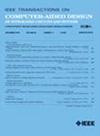An Optimization-Aware Prerouting Timing Prediction Framework Based on Multimodal Learning
IF 2.9
3区 计算机科学
Q2 COMPUTER SCIENCE, HARDWARE & ARCHITECTURE
IEEE Transactions on Computer-Aided Design of Integrated Circuits and Systems
Pub Date : 2025-03-04
DOI:10.1109/TCAD.2025.3547806
引用次数: 0
Abstract
Accurate and efficient prerouting timing estimation is particularly crucial during placement to alleviate time-consuming design iterations. Machine-learning (ML)-based methods have been introduced recently to predict the post-routing timing results at placement stage, but most of them neglect the impact of timing optimization during physical design, suffering from accuracy loss due to inconsistent circuit netlist. In this work, an optimization-aware prerouting timing prediction framework based on multimodal learning is proposed to calibrate the timing changes between placement and routing stages, where the local netlist and layout information are extracted by graph neural network (GNN) and convolutional neural network (CNN), respectively, while the global information along the path is further extracted by Transformer network. Based on the predicted post-routing timing results by the proposed framework, timing optimization guidance is generated to enhance traditional design flow with better physical implementation quality. Experimental results demonstrate that for the OpenCores benchmark circuits under TSMC 22nm process, the proposed framework achieves significant correlation and accuracy improvement with an average of 0.9219 in terms of R2 score and 2.12% of mean absolute percentage error (MAPE) as well as an average runtime acceleration of基于多模态学习的优化感知预路由时间预测框架
准确和有效的预路由时间估计在放置过程中特别重要,以减少耗时的设计迭代。近年来,基于机器学习(ML)的方法被引入到布线后的时序预测中,但大多数方法忽略了物理设计中时序优化的影响,由于电路网表不一致而导致精度损失。本文提出了一种基于多模态学习的优化感知预路由时序预测框架,该框架通过图神经网络(GNN)和卷积神经网络(CNN)分别提取局部网表和布局信息,同时通过Transformer网络进一步提取路径沿线的全局信息。基于该框架对路由后时序结果的预测,生成时序优化指导,以更好的物理实现质量增强传统设计流程。实验结果表明,对于TSMC 22nm制程下的OpenCores基准电路,与传统设计流程相比,该框架在测试设计上的R2得分平均为0.9219,平均绝对百分比误差(MAPE)平均为2.12%,平均运行时加速为645倍。在时序优化指导下,与传统流相比,布置和布线后的最坏负松弛量(WNS)和总负松弛量(TNS)均有显著改善,且面积、功率、导线长度和设计规则校验(DRC)违规次数均未明显增加。
本文章由计算机程序翻译,如有差异,请以英文原文为准。
求助全文
约1分钟内获得全文
求助全文
来源期刊
CiteScore
5.60
自引率
13.80%
发文量
500
审稿时长
7 months
期刊介绍:
The purpose of this Transactions is to publish papers of interest to individuals in the area of computer-aided design of integrated circuits and systems composed of analog, digital, mixed-signal, optical, or microwave components. The aids include methods, models, algorithms, and man-machine interfaces for system-level, physical and logical design including: planning, synthesis, partitioning, modeling, simulation, layout, verification, testing, hardware-software co-design and documentation of integrated circuit and system designs of all complexities. Design tools and techniques for evaluating and designing integrated circuits and systems for metrics such as performance, power, reliability, testability, and security are a focus.

 求助内容:
求助内容: 应助结果提醒方式:
应助结果提醒方式:


